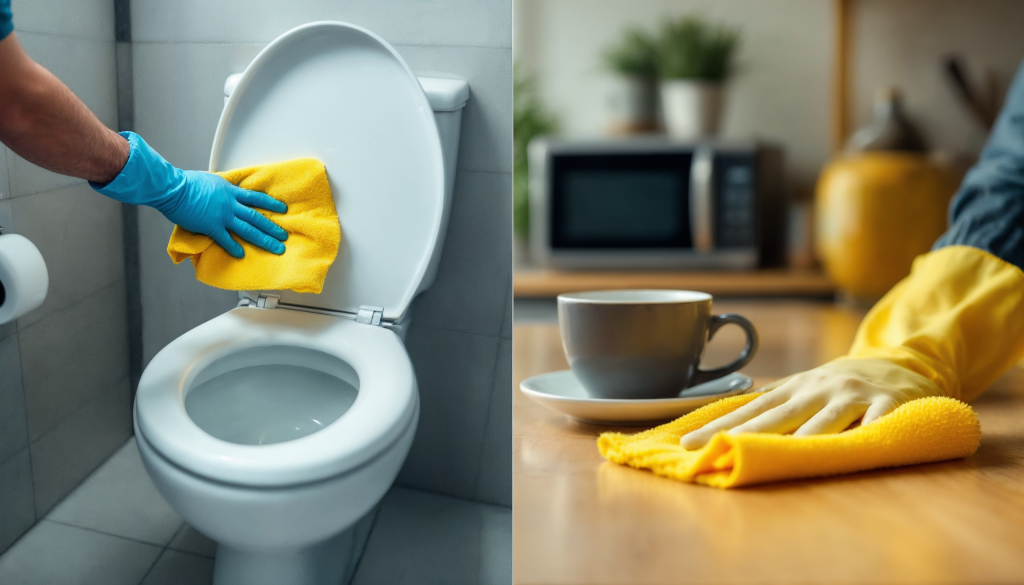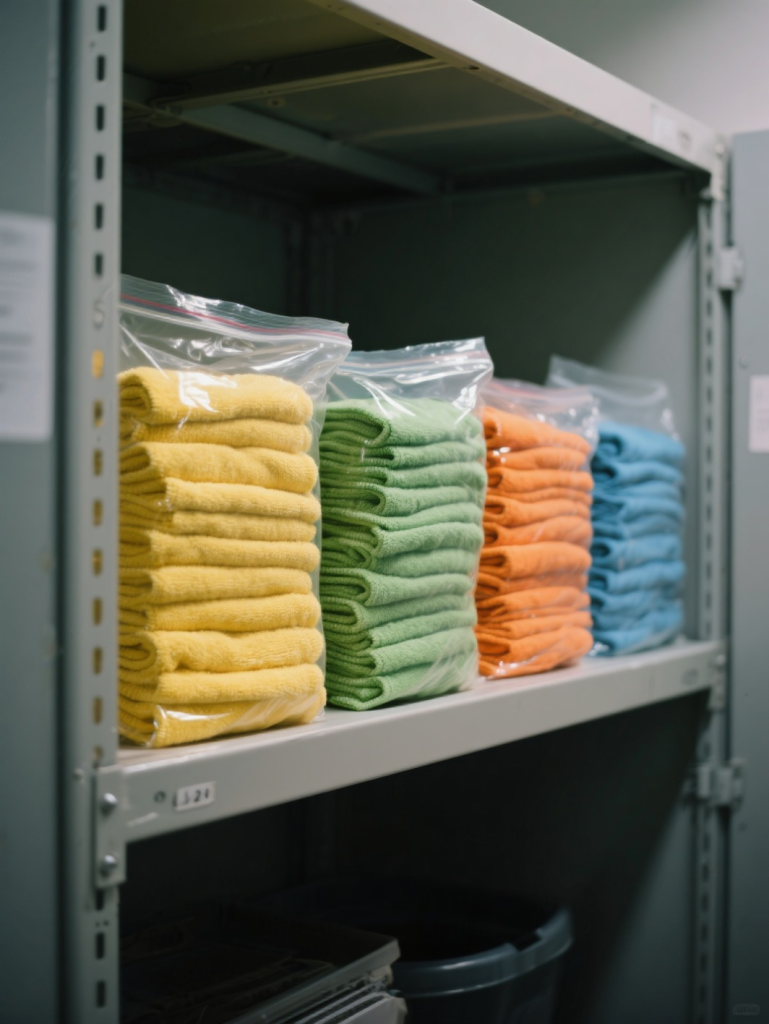Color-Coded Towels: A Non-Negotiable for Every Commercial Cleaning Company
From Bathroom to Boardroom: The Dirty Truth Hiding in Most Offices

I’ve walked into too many buildings where the cleaning cart tells the whole story: a single, grayish towel doing laps from the restroom to the break room to the CEO’s office. That’s not cleaning—that’s cross‑contamination on wheels.
This guide explains how proper microfiber use and color‑coding protect your people, your reputation, and your bottom line. It’s not theory—it’s what we enforce on every job site. Read this with the mindset of an auditor. If your current provider can’t show you how they control their towels, assume they don’t.
Why Towels Decide Whether Your Building Stays Healthy
Microfiber is a fantastic tool—when it’s used correctly. When it isn’t, it becomes a high‑efficiency germ delivery system. Here’s why towels are make‑or‑break:
They’re everywhere. Door handles, restroom fixtures, elevator buttons, desks, break rooms—if a surface is touched, a towel was probably there first.
They hold on to everything. Microfiber’s split fibers pick up residues and microbes incredibly well. If those towels aren’t segregated and laundered correctly, whatever they grabbed gets redeposited somewhere else.
They can neutralize your disinfectants. Dirty towels reduce contact time effectiveness and can deactivate chemistry. That means you’re wiping with false confidence.
If your cleaners treat all towels as interchangeable, you are one wipe away from restroom bacteria being rubbed onto a conference room table. You don’t want that sentence to ever describe your building.
The Non‑Negotiable Rule: Color‑Coding (and Strict Segregation)
Color‑coding isn’t “nice to have.” It’s a hard control that prevents cross‑contamination. We document it, train it, and audit it. Here’s the model we deploy and enforce:
Yellow = Restroom fixtures only. We reserve yellow exclusively for restroom fixtures because those towels go through a more complex, high‑control cleaning process. Yellow never leaves the restroom zone.
Red = Toilets/urinals and high‑risk bio‑areas. Red is single‑purpose and never mixes with other colors—period.
Blue = General office touchpoints. Desks, glass, door hardware, partitions (excluding food/restroom zones).
Green = Food/Break areas. Counters, appliances, sinks (no restroom crossover, ever).
Key point: Color is just the start. Towels must be bagged, labeled, transported, and laundered by color and use. If the chain of custody breaks at any point, your protection fails.

What “Good” Looks Like (A Gold‑Standard Towel Program)
1) Point‑of‑Use Controls
Dedicated caddies for each zone with sealed packs of clean towels (not loose on a cart).
Pre‑mixed, labeled bottles with correct disinfectant contact times listed where they can’t be ignored.
Soiled towels bagged at the point of use—no roaming across hallways.
2) Handling & Transport
Sealed, color‑matched bags with date/time and area logged on a tag or in an app.
Separate transport bins for restroom, general office, and food‑area textiles—no shared bins.
3) Laundering That Actually Decontaminates
Separate wash cycles by color and use category (restroom loads isolated).
Approved detergents for microfiber (no fabric softeners or additives that coat fibers and kill absorption).
Water temperature and chemical program validated by the towel manufacturer and disinfectant supplier.
Measured drying (overheating damages split fibers; under‑drying breeds odor and microbial growth).
Spot checks: ATP or fluorescence testing on random lots to verify soils are removed.
4) Inventory & Retirement
Towel rotation tracking by color and age; retired when they lose loft/absorption or show staining that won’t release.
Serialized or batched inventory so nothing “mystery‑meat” slips through.
5) People & Proof
Documented training with pass/fail checklists and coaching ride‑alongs.
Monthly audits with corrective actions and photo records.
The Hidden Costs When This Isn’t Done Right
Most buildings only see the obvious costs—supplies, labor hours, service fees. Missed towel controls create costs you don’t see until it’s expensive:
Illness ripple effects. One cross‑contamination event in a restroom can travel through a building quickly, especially via shared touchpoints. Even a small wave of sick days drains productivity and morale.
Complaints that multiply. Odors, sticky surfaces, smudged glass, recurring restroom issues—these are signs of contaminated or coated microfiber. Your team notices, even if they don’t say it out loud.
Reputation hits. Tenants talk. Prospects tour. One grimy restroom can erase months of good impressions.
Contract liability. If a vendor can’t show process controls, logs, and training, you’re carrying their risk.
If your vendor shrugs at color‑coding or laundering specifics, they’re not protecting you; they’re gambling with your building’s health.
How to Audit Your Current Cleaner in 10 Minutes
You don’t need a lab coat—just ask and observe. Use this in your next walkthrough:
“Show me your color map.” Ask for the written color‑coding plan that defines where each towel can and cannot go. No document = no control.
“Open your sealed stock.” Clean towels should be sealed or clearly protected by zone, not loose in a bin picking up dust.
“Where do soiled towels go?” You want bagging at the point of use, labeled by color/area, and separate transport containers.
“Walk me through your laundry program.” Listen for: separated loads, approved chemistries, no softener, validated temperatures, logs.
“How do you verify effectiveness?” Look for ATP or other periodic checks, not just “we’ve always done it this way.”
“What’s your retirement policy?” Frayed, flat, gray towels should be out of circulation.
“What happens when someone breaks protocol?” There should be retraining and documentation—not a shrug.
Red flags you can see in seconds:
One towel doing everything on the cart.
Towels that smell like perfume (that’s softener—bad for microfiber performance).
Gray, stained, or slimy‑feeling cloths.
Unlabeled spray bottles and mystery chemistry.
No logs, no dates, no traceability.
Restrooms: The Highest‑Risk Zone (and the Yellow‑Only Standard)
Restrooms are where cross‑contamination starts if you let it. Our program treats them like a bio‑controlled environment:
Yellow towels only for restroom fixtures, reserved and tracked separately, then run through a more complex clean cycle.
Blue towels solely for glass.
Never leave the zone or mix with orange/green general or food‑area towels.
Dwell time enforced for disinfectants—no “wipe and run.”
Hands last. After surfaces are finished, technicians remove gloves, sanitize hands, and then touch door hardware.
If your current vendor casually carries towels from a restroom to a break room, it’s not a small miss—it’s a systemic failure.
Microfiber Mistakes That Quietly Undermine Your Cleaning
Fabric softener or dryer sheets. They coat fibers, reduce absorption, and leave behind residues that smear instead of clean.
Wrong chemistry pairings. Some disinfectants require specific contact times or will be neutralized by high soil loading.
Overheating in the dryer. Damages split fibers; towels look fine but stop performing.
Reusing “just for one more wipe.” Once a towel has done its job in a zone, it’s done for that zone. Bag it.
What You Should Expect in Writing
Insist on these deliverables from any professional cleaning partner:
A documented Color‑Coding & Cross‑Contamination Control Plan specific to your building.
Laundering SOPs that name the detergents, temperatures, and cycle types approved for microfiber.
Training records and a cadence for recurrent training (new hires and refreshers).
Audit schedule with results shared (and fixes tracked) monthly or quarterly.
Incident protocol for any breach of segregation (what happens, who’s notified, and how it’s corrected).
If it isn’t documented, it doesn’t exist.
A Simple Decision Framework for Building Owners
Ask yourself:
Can my cleaner prove their towel controls today? Not tell you—prove to you.
Would I eat in the break room after watching their process? If the answer is “not a chance,” your tenants already feel the same way.
If a health complaint lands on my desk tomorrow, do I have the documentation to show that reasonable, industry‑standard controls were in place? Or am I hoping?
If you’re relying on hope, your building is relying on luck. That’s not a strategy.
Closing Thought from a Seasoned Owner
We built our reputation by obsessing over unglamorous details like towel segregation, laundry chemistry, and dwell times. Those details keep buildings healthy and people safe. You don’t need to become an expert—but you do need a partner who already is.
If you want a quiet, confidential look at how your current towel program stacks up, I’m happy to walk you through an on‑site audit checklist and let the facts speak for themselves.
If you’re current cleaning service can’t pass the audit, 180 Elite Cleaning is happy to step in. We’re Kansas City’s most trusted commercial cleaning company. Our customers health and productivity is top priority. Schedule a walkthrough today or give us a call!

